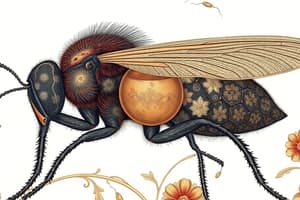Podcast
Questions and Answers
What distinguishes incomplete metamorphosis from complete metamorphosis in insects?
What distinguishes incomplete metamorphosis from complete metamorphosis in insects?
- Nymphs directly develop into adults without a pupal stage. (correct)
- Nymphs do not undergo any molting.
- Adults of incomplete metamorphosis do not have wings.
- Larvae undergo extensive anatomical changes during a pupal stage.
How does population density affect insect development and reproduction?
How does population density affect insect development and reproduction?
- Higher density always leads to increased reproductive success.
- Population density has no effect on development.
- Lower population density can enhance growth rates due to reduced competition. (correct)
- High population density guarantees a longer lifespan for insects.
Which factor does NOT significantly influence insect development and reproductive output?
Which factor does NOT significantly influence insect development and reproductive output?
- Photoperiod
- Temperature and humidity
- Nutritional intake
- Seasonal migration patterns (correct)
What is the primary role of the pupal stage in complete metamorphosis?
What is the primary role of the pupal stage in complete metamorphosis?
Why is understanding reproductive strategies in insects important?
Why is understanding reproductive strategies in insects important?
What is the primary advantage of asexual reproduction for insect populations in stable environments?
What is the primary advantage of asexual reproduction for insect populations in stable environments?
In sexual reproduction among insects, which of the following statements is true about copulation?
In sexual reproduction among insects, which of the following statements is true about copulation?
Which type of parthenogenesis results in all female offspring from unfertilized eggs?
Which type of parthenogenesis results in all female offspring from unfertilized eggs?
What role do environmental factors play in insect reproduction?
What role do environmental factors play in insect reproduction?
Which of the following is true about fertilization methods in insects?
Which of the following is true about fertilization methods in insects?
What is a characteristic feature of insects that undergo metamorphosis?
What is a characteristic feature of insects that undergo metamorphosis?
How does parthenogenesis affect male and female development in arrhenotokous parthenogenesis?
How does parthenogenesis affect male and female development in arrhenotokous parthenogenesis?
What is the function of an ovipositor in female insects?
What is the function of an ovipositor in female insects?
Flashcards
Incomplete Metamorphosis
Incomplete Metamorphosis
A type of insect development where young resemble smaller adults and gradually grow wings and reproductive organs through molting.
Complete Metamorphosis
Complete Metamorphosis
A type of insect development with distinct, dramatically different stages: larva, pupa, adult. Larvae are different from adults and focus on eating, pupae are inactive, and adults emerge with wings and reproductive structures.
Nymph
Nymph
The young stage in insects that undergo incomplete metamorphosis, resembling a smaller version of the adult.
Pupa
Pupa
Signup and view all the flashcards
Larva
Larva
Signup and view all the flashcards
Sexual Reproduction
Sexual Reproduction
Signup and view all the flashcards
Asexual Reproduction
Asexual Reproduction
Signup and view all the flashcards
Parthenogenesis
Parthenogenesis
Signup and view all the flashcards
Metamorphosis
Metamorphosis
Signup and view all the flashcards
Arrhenotokous Parthenogenesis
Arrhenotokous Parthenogenesis
Signup and view all the flashcards
Deuterotokous Parthenogenesis
Deuterotokous Parthenogenesis
Signup and view all the flashcards
Thelytokous Parthenogenesis
Thelytokous Parthenogenesis
Signup and view all the flashcards
Apomixis
Apomixis
Signup and view all the flashcards
Study Notes
Modes of Reproduction
- Insects exhibit diverse reproductive strategies, categorized as sexual and asexual.
- Sexual reproduction involves gamete fusion from two parents, creating genetic variation. This is the most common method.
- Asexual reproduction, less common, includes parthenogenesis, where females produce offspring from unfertilized eggs. This can cause rapid population growth in stable environments.
- Parthenogenesis can be cyclical (alternating between sexual and asexual reproduction).
- Some species adapt their reproductive method based on environmental cues.
Sexual Reproduction in Insects
- Most insects employ internal fertilization, often through copulation.
- Females have specialized ovipositors for egg-laying, with diverse forms and functions based on species and oviposition location.
- External fertilization occurs in some aquatic insects, releasing eggs and sperm into the water. Large numbers of offspring compensate for low survival rates.
- Sperm transfer mechanisms differ across insect orders (e.g., spermatophores).
- Courtship rituals, using behaviors and chemical/visual signals, precede mating in some species.
Asexual Reproduction in Insects
- Parthenogenesis is a common asexual method.
- Arrhenotokous parthenogenesis: unfertilized eggs produce males, fertilized eggs produce females.
- Deuterotokous parthenogenesis: both sexes from unfertilized eggs.
- Thelytokous parthenogenesis: all offspring are females, produced from unfertilized eggs.
- Apomixis is another asexual method, producing genetically identical offspring without specialized sex cells (similar to plants).
- Environmental factors trigger shifts between sexual and asexual reproduction, e.g., stress can stimulate asexual reproduction.
- Some insects modify reproductive strategies throughout their life cycle.
Insect Development
- Insects undergo metamorphosis, transforming from immature to adult forms.
- Incomplete metamorphosis involves a gradual change from larvae to adults (e.g., grasshoppers, roaches).
- Nymphs resemble adults but lack wings and reproductive structures.
- Nymphs repeatedly molt, increasing in size and developing wings and sexual maturity.
- Complete metamorphosis involves distinct larval, pupal, and adult stages (e.g., butterflies, moths, beetles).
- Larvae have different body structures from adults.
- Larvae feed extensively and grow rapidly.
- Pupae are quiescent (often in cocoons) undergoing major anatomical changes.
- Adults emerge with developed wings and reproductive structures.
- Developmental stages have different ecological roles.
Factors Influencing Reproduction and Development
- Nutrition is critical for insect development and reproduction, affecting growth rate and offspring production.
- Temperature, humidity, and photoperiod influence insect development, reproductive success, and the timing of development.
- Population density is a factor.
- Predation on insects influences offspring numbers and development.
- Disease susceptibility impacts lifespan and reproductive success.
Significance of Reproductive Strategies
- Insect reproductive diversity ensures population persistence and adaptation to various ecological conditions.
- Studying reproductive strategies is essential for understanding insect populations and developing effective pest management.
Studying That Suits You
Use AI to generate personalized quizzes and flashcards to suit your learning preferences.




